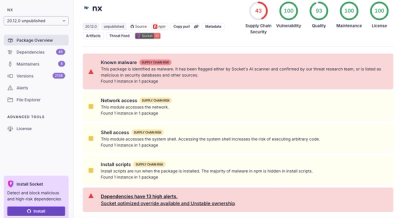
Security News
Risky Biz Podcast: Making Reachability Analysis Work in Real-World Codebases
This episode explores the hard problem of reachability analysis, from static analysis limits to handling dynamic languages and massive dependency trees.
node-red-contrib-web-of-things
Advanced tools
A Node-RED package of nodes for the Web of Things.
Can be installed from the Node-RED palette manager directly or via npm (see the npm package). The package provides nodes that can communicate with any HTTP/HTTPS, WebSocket, CoAP/CoAPS, MQTT, OPC UA and Modbus device based on its W3C WoT Thing Description.
The package is build upon node-wot runtime environment.
After installation the package adds 4 different nodes at the Node-RED palette, all together scoped under "Web of Things" title. Those nodes are as follows and needed to interact with different interaction affordances of a Thing:

In order to consume a Thing and interact with it, drag and drop one of the interaction nodes to a flow. Then double click on that node. Inside the opened window click the pencil icon next to "Add new consumed-thing..." dropdown.

A new window will appear.

Now either copy-paste/type in a Thing Description inside the TD JSON box or fetch a Thing Description from a URL. Tip: In case you choose the first option, click on the three dots to expand the JSON editor.
After you click "Process"/"Fetch", all protocol bindings supported by the Thing will be enabled (except they are not supported by this package). Now you can leave only the bindings you need, and disable the others. Or you can leave them all as they are. Anyway, this can be changed at any time.
If a Thing needs basic authentication (i.e. using username and password) for any of its interaction affordances, you can enable that in the respective checkbox. Note: Only basic type of authentication is currently supported by this package. If you enable security, the nodes will automatically infer whether to use authentication for this particular affordance or not based on the provided Thing Description.
Finally, click on the red "Add" button on the top right corner.
Now, for all WoT nodes you add to a flow, you will see all the respective interaction affordances populated from the Thing Description.
You can also add more Things and choose a particular one for any node you add.
In order to see a fetched property value you can wire it with the "debug" node of Node-RED, and see all the values inside the "Debug messages" tab of Node-RED. In order to write to a property, wire an "inject" node with the "Write Property" node. In the "inject" node, select JSON format as payload and plug in your value.
To send an input for an action you can also wire it with the "inject" node as explained above. Tip: In order to invoke an action that does not require any input, wire it with an empty "inject" node.
Properties and Actions also support uriVariables. They can be specified inside "Read Property"/"Write Property"/"Invoke Action" node properties.
Subscribing to an event is pretty much the same as reading a property.
Overall, a basic flow may look like this.

Exposing Things is currently not available within this package but might be added later.
FAQs
Web of Things node for node-RED.
We found that node-red-contrib-web-of-things demonstrated a not healthy version release cadence and project activity because the last version was released a year ago. It has 4 open source maintainers collaborating on the project.
Did you know?

Socket for GitHub automatically highlights issues in each pull request and monitors the health of all your open source dependencies. Discover the contents of your packages and block harmful activity before you install or update your dependencies.

Security News
This episode explores the hard problem of reachability analysis, from static analysis limits to handling dynamic languages and massive dependency trees.

Security News
/Research
Malicious Nx npm versions stole secrets and wallet info using AI CLI tools; Socket’s AI scanner detected the supply chain attack and flagged the malware.

Security News
CISA’s 2025 draft SBOM guidance adds new fields like hashes, licenses, and tool metadata to make software inventories more actionable.